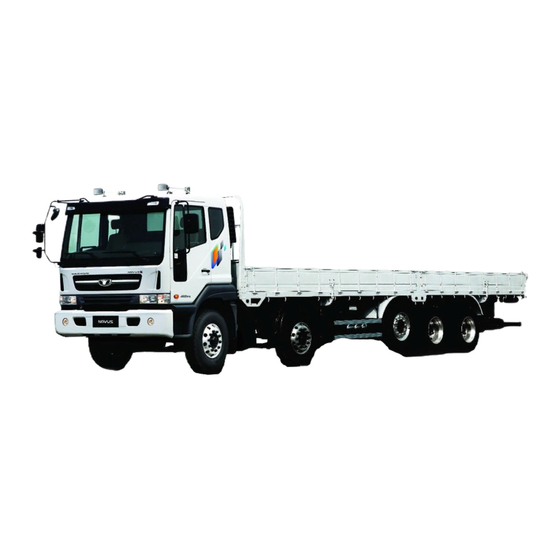
Table of Contents
Advertisement
Quick Links
We would like to take this opportunity to thank you for choosing a TATA
DAEWOO product and assure you for our continuing interest in your
motoring pleasure and satisfaction.
This manual has been prepared to acquaint you with the operation and
Maintenance of your new TATA DAEWOO TRUCK and to provide
important safety information. We urge you to read it carefully and follow
the recommendation to help assure the most enjoyable, safe and
trouble‐free operation of your vehicle.
When it comes to service, remember that your TATA DAEWOO dealer
knows your vehicle best and is interested in your full satisfaction.
This manual should be considered as a permanent part of your vehicle,
and must remain with the vehicle at the time of resale.
All information, illustrations and specifications contained in this manual
are based on the latest product information available at the time of
publication.
The right is reserved to make changes at any time without notice.
https://www.truck-manuals.net/
FOREWORD
FOREWORD
TATA DAEWOO COMMERCIAL VEHICLE
Advertisement
Table of Contents
Troubleshooting

Summarization of Contents
1. HOW TO HANDLE THE VEHICLE
1. OPERATION OF NEW VEHICLE
Guidance on proper break-in procedures, oil changes, and engine warm-up for new vehicles.
2. OPERATION OF CAB TILT
Detailed steps for safely lifting and lowering the vehicle cab for access or maintenance.
3. OPENING OR CLOSING OF FRONT LID
Procedure for opening and closing the front lid to access engine bay components for checks.
4. INSTRUMENTS AND CONTROLS
Overview of dashboard indicators, gauges, and control switches for vehicle operation.
5. Miscellaneous controls
Explanation of various controls like gearshift lever, pedals, mirrors, and interior lamps.
2. DRIVING
1. BEFORE STARTING THE ENGINE
Essential checks of engine oil, clutch fluid, washer fluid, tires, chassis springs, battery, and brakes before starting.
2. STARTING AND STOPPING THE ENGINE
Procedures for starting the engine (DE/DV and DDC types) in various conditions and proper engine stopping methods.
3. BEFORE DRIVING OFF
Pre-drive checks including steering wheel play, parking brake function, windshield wipers, and instrument panel indicators.
4. WHEN DRIVING OFF
Steps to follow when starting to drive the vehicle, ensuring proper air pressure and brake release.
5. DRIVING FOR ECONOMY
Tips for economical driving, including checking points, avoiding harsh maneuvers, and proper use of accessories.
6. WHILE TRAVELING
Important considerations during travel, such as engine break-in, monitoring warning lamps, and coolant temperature.
7. TRAVEL ON HIGHWAY
Specific checks and precautions for safe highway driving, including tire selection, speed perception, and braking distance.
8. OPERATION AND CARE IN HOT WEATHER
Procedures for operating and maintaining the vehicle in hot weather, focusing on the cooling system and tire pressure.
9. OPERATION AND CARE IN COLD WEATHER
Guidelines for operating and maintaining the vehicle in cold weather, covering engine protection, antifreeze, and battery care.
3. INSPECTION AND MAINTENANCE
1. DAILY CHECK BEFORE DRIVING
Daily inspection checklist covering steering, brakes, running gear, suspension, engine, powertrain, and dump system controls.
2. PERIODIC INSPECTION AND MAINTENANCE
Detailed schedule and procedures for periodic maintenance of engine oil, filters, transmission, axles, and steering systems.
3. PERIODIC INSPECTION CHART
Comprehensive chart detailing service intervals for various engine, clutch, transmission, chassis, and electrical components.
4. IN CASE OF EMERGENCY
Procedures for emergency stopping, starting, and towing a vehicle, including battery jumping and towing precautions.
5. VEHICLE REPAIR
Guidelines for vehicle cleaning and polishing to maintain appearance and protect components.
4. TROUBLESHOOTING AND CORRECTIONS
1. ENGINE AND RELATED PARTS
Common engine-related issues and their causes and corrections, including starter, fuel, oil, and smoke problems.
2. CHASSIS AND RELATED PARTS
Troubleshooting guide for chassis components like transmission noise, steering issues, tire wear, and brake problems.
3. ELECTRICAL
Common electrical issues such as battery discharge and lamp malfunctions, with causes and corrective actions.
4. DUMP
Troubleshooting specific to the dump system, including issues with vessel lifting and smooth raising.
5. MISCELLANEOUS CONTROLS AND OPTIONS
1. TACHOGRAPH(option)
Details on tachograph construction, reading records, and handling chart paper for speed and trip monitoring.
2. AIR SUSPENSION SEAT(option)
Explanation of the air suspension seat controls for adjusting slide, lumbar support, height, tilt, and back angle.
3. AUTO GREASER(option)
Information on the auto greaser system, including operating rules for the gear pump, distributor, control unit, and pressure switch.
4. TURBO CHARGER
Basic operation, types, operating tips, and care instructions for the turbocharger to prevent damage and ensure efficiency.
5. ZF TRANSMISSION
Details on ZF transmission construction, pneumatic control diagrams, operation, and gear shifting procedures.
6. OPERATION OF DUMP SYSTEM
Instructions for operating the dump system, including inspection, raising/lowering the deck, and safety cautions.
7. OPERATION OF TRACTOR-TRAILER
Guidance on driving, connecting, disconnecting, and precautions for tractor-trailer operations.
8. BULK CEMENT TRACTOR
Information on bulk cement tractor external views, compressor specifications, diagrams, operation cautions, and troubleshooting.
9. SELF STEER
Maintenance and troubleshooting procedures for the self-steer system, including air pressure adjustment.
10. HYDRAULIC DEVICE FOR CAR CARRIER
Details on the hydraulic system for car carriers, including circuit diagrams, oil specifications, and hose connections.
11. TOOL LIST
List of standard and optional tools provided with the vehicle for maintenance and repair.
12. SERVICE ELECTRIC EQUIPMENTS FOR USER
Information on special harnesses for optional electrical equipment like cellular phone chargers and working lamps.
6. SPECIFICATIONS AND SERVICE DATA
1. LOCATION OF CHASSIS NUMBER AND ENGINE NUMBER
Identification of vehicle, chassis, and engine numbers for parts ordering and servicing.
2. MAIN DATA
General, power train, chassis, and cab specifications for various vehicle models.
3. RECOMMENDED LUBRICANTS
Table of recommended fluids and capacities for engine, transmission, axles, brakes, and other systems.






Need help?
Do you have a question about the Novus K4MVF and is the answer not in the manual?
Questions and answers